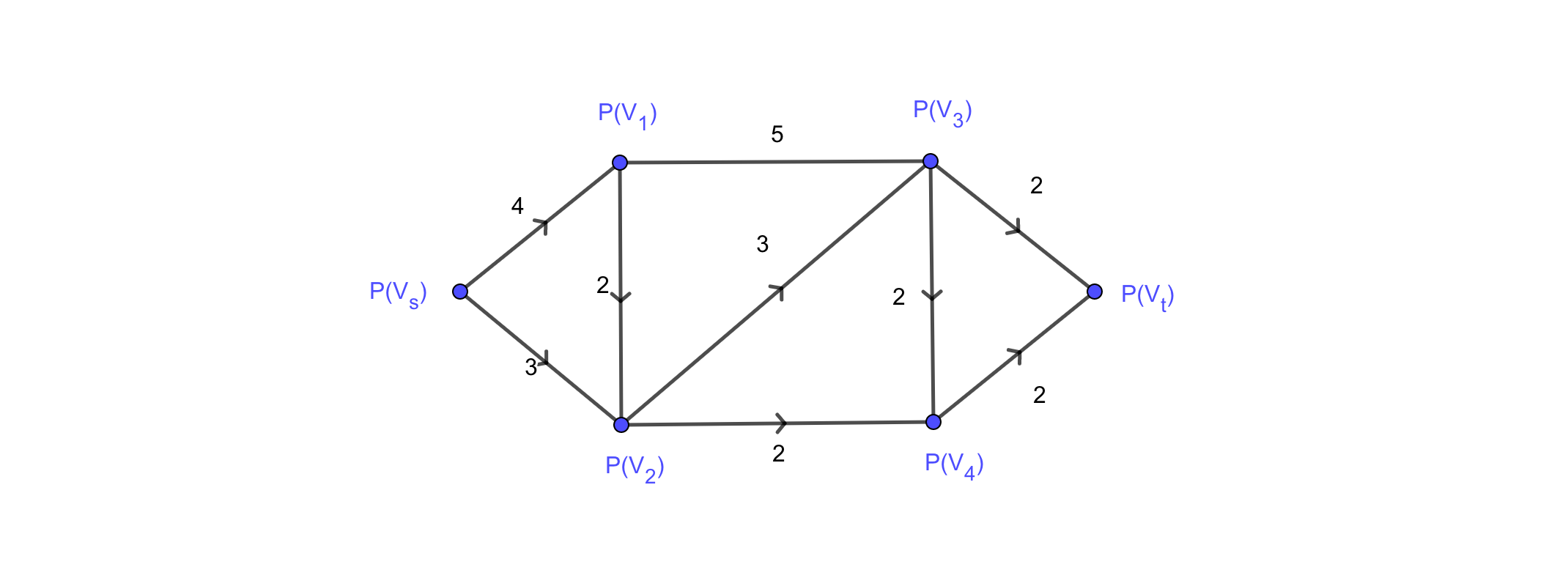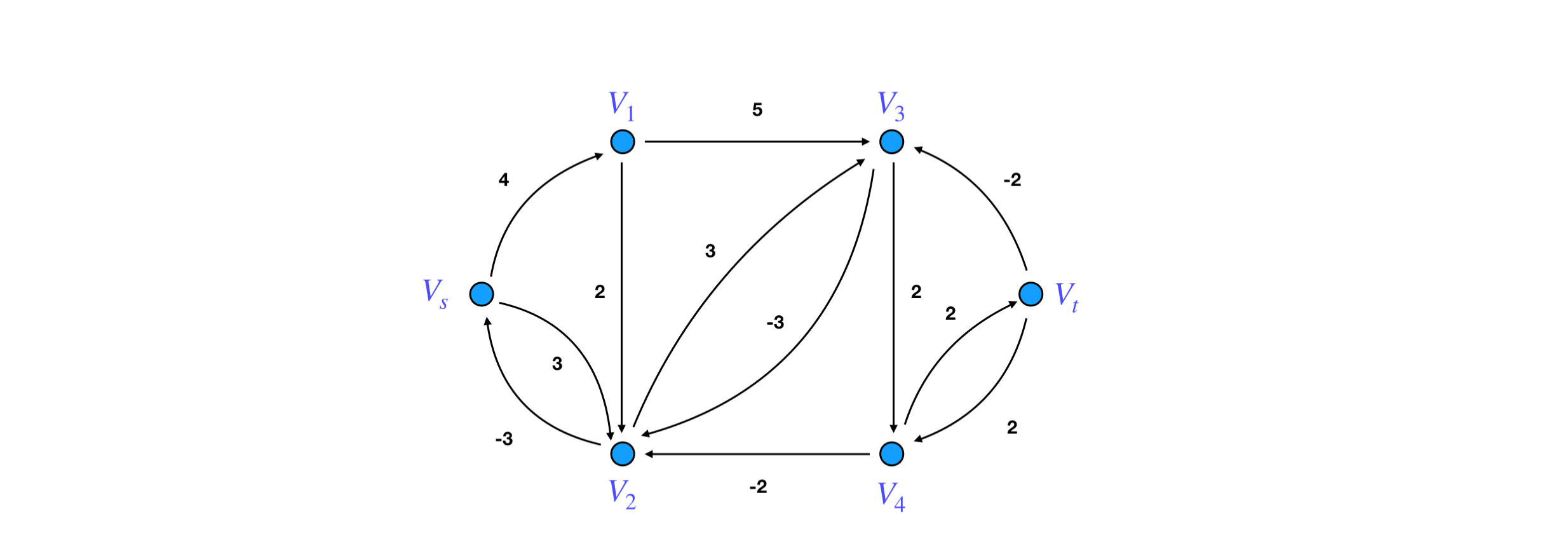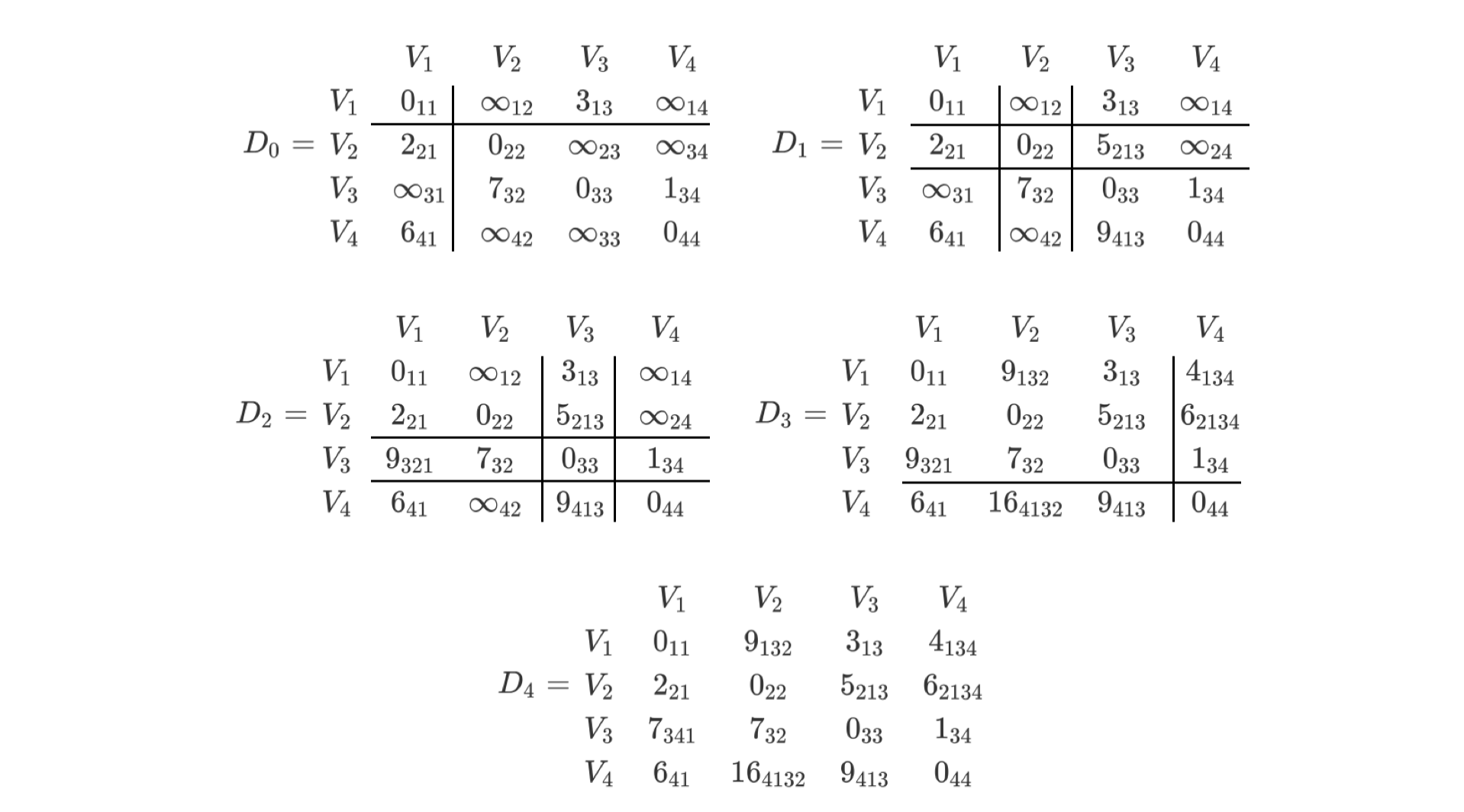1 最大流问题
1.1 记号简记
无向图
#card=math&code=G%3D%28V%2CE%29&height=16&width=65),顶点集合
,边集合
,边
。
有向图
#card=math&code=D%3D%28V%2CA%29&height=16&width=66),顶点集合
,弧集合
,弧
#card=math&code=%28v_i%2Cv_j%29&height=17&width=39)。
图的支撑树
由图的 个节点与
条边组成的树为图的支撑树。
以下例介绍求最小支撑树的两种方法:

1.2 避圈法
,令
,从
中选最小权边
;
,从
中选最小权边
, 且
#card=math&code=%28v%2CE_1%5Ccup%5C%7B%5Bv_2%2Cv_4%5D%5C%7D%29&height=16&width=107) 不含圈,令
;
,从
中选最小权边
, 且
#card=math&code=%28v%2CE_2%5Ccup%5C%7B%5Bv_4%2Cv_5%5D%5C%7D%29&height=16&width=107) 不含圈,令
;
,从
中选最小权边
, 且
#card=math&code=%28v%2CE_3%5Ccup%5C%7B%5Bv_5%2Cv_6%5D%5C%7D%29&height=16&width=107) 不含圈,令
;
,从
中选最小权边
, 且
#card=math&code=%28v%2CE_4%5Ccup%5C%7B%5Bv_1%2Cv_2%5D%5C%7D%29&height=16&width=107) 不含圈,令
;
,任一条未选边都与已选边构成圈,接待终止,
,
#card=math&code=%28v%2CE_5%29&height=16&width=39) 就是最小支撑树。
1.3 破圈法
取圈 #card=math&code=%28v_1%2Cv_2%2Cv_3%2Cv_1%29&height=16&width=79),边
的权最大,去掉
;
取圈 #card=math&code=%28v_3%2Cv_5%2Cv_2%2Cv_3%29&height=16&width=79),边
的权最大,去掉
;
取圈 #card=math&code=%28v_3%2Cv_5%2Cv_4%2Cv_2%2Cv_3%29&height=16&width=98),边
的权最大,去掉
;
取圈 #card=math&code=%28v_5%2Cv_6%2Cv_4%2Cv_5%29&height=16&width=79),边
的权最大,去掉
,得到不含圈的图,即为最小支撑树。
2 最短路
2.1 Dijkstra 标号法

- 适用于求
的最短路,权非负。
- 步骤:
- 令
,令
,令
%3Dmin%5C%7B6%2C9%5C%7D%3D6#card=math&code=T%28V_3%29%3Dmin%5C%7B6%2C9%5C%7D%3D6&height=16&width=135),令
,令
%3Dmin%5C%7B7%2C8%5C%7D%3D7#card=math&code=T%28V_t%29%3Dmin%5C%7B7%2C8%5C%7D%3D7&height=16&width=133),令
- 故最短路为:
#card=math&code=%28V_s%2CV_2%2CV_4%2CV_t%29&height=16&width=82)
2.2 逐次逼近法

- 适用于求
到任意一点的最短路。
- 权可负。
%7D%20%26%20p%7Bij%7D%5E%7B(2)%7D%20%26%20p%7Bij%7D%5E%7B(3)%7D%20%26%20p%7Bij%7D%5E%7B(4)%7D%20%26%20p%7Bij%7D%5E%7B(5)%7D%5C%5C%0AVs%20%26%200%20%26%204%20%26%203%20%26%20%26%20%26%20%26%200%20%26%200%20%26%200%20%26%200%20%26%200%5C%5C%20%20%0AV_1%20%26%20%20%26%200%20%26%202%20%26%205%20%26%20%26%20%26%204%20%26%204%20%26%204%20%26%204%20%26%204%5C%5C%0AV_2%20%26%20-3%20%26%20%20%26%200%20%26%20%5Cunderline%20%7B3%7D%20%20%26%20%26%20%26%203%20%26%203%20%26%203%20%26%203%20%26%203%5C%5C%20%0AV_3%20%26%20%20%26%20%20%26%20-3%20%26%200%20%26%20%5Cunderline%20%7B2%7D%20%20%26%20%26%20%20%26%20%5Cunderline%20%7B6%7D%20%20%26%206%20%26%206%20%26%206%5C%5C%20%0AV_4%20%26%20%20%26%20%20%26%20-2%20%26%20%26%200%20%26%20%5Cunderline%20%7B2%7D%20%20%26%20%20%26%20%20%26%20%5Cunderline%20%7B8%7D%20%20%26%208%20%26%208%5C%5C%20%0AV_t%20%26%20%20%26%20%20%26%20%20%26%20-2%20%26%20-2%20%26%200%20%26%20%20%26%20%20%26%20%20%26%20%5Cunderline%20%7B10%7D%20%20%26%2010%5C%5C%20%0A%5Cend%7Bmatrix%7D%0A#card=math&code=%5Cbegin%7Bmatrix%7D%0A%20%20%26%20%20V_s%20%26%20V_1%20%26%20V_2%20%26%20V_3%20%26%20V_4%20%26%20V_t%20%26%20p%7Bij%7D%5E%7B%281%29%7D%20%26%20p%7Bij%7D%5E%7B%282%29%7D%20%26%20p%7Bij%7D%5E%7B%283%29%7D%20%26%20p%7Bij%7D%5E%7B%284%29%7D%20%26%20p%7Bij%7D%5E%7B%285%29%7D%5C%5C%0AV_s%20%26%200%20%26%204%20%26%203%20%26%20%26%20%26%20%26%200%20%26%200%20%26%200%20%26%200%20%26%200%5C%5C%20%20%0AV_1%20%26%20%20%26%200%20%26%202%20%26%205%20%26%20%26%20%26%204%20%26%204%20%26%204%20%26%204%20%26%204%5C%5C%0AV_2%20%26%20-3%20%26%20%20%26%200%20%26%20%5Cunderline%20%7B3%7D%20%20%26%20%26%20%26%203%20%26%203%20%26%203%20%26%203%20%26%203%5C%5C%20%0AV_3%20%26%20%20%26%20%20%26%20-3%20%26%200%20%26%20%5Cunderline%20%7B2%7D%20%20%26%20%26%20%20%26%20%5Cunderline%20%7B6%7D%20%20%26%206%20%26%206%20%26%206%5C%5C%20%0AV_4%20%26%20%20%26%20%20%26%20-2%20%26%20%26%200%20%26%20%5Cunderline%20%7B2%7D%20%20%26%20%20%26%20%20%26%20%5Cunderline%20%7B8%7D%20%20%26%208%20%26%208%5C%5C%20%0AV_t%20%26%20%20%26%20%20%26%20%20%26%20-2%20%26%20-2%20%26%200%20%26%20%20%26%20%20%26%20%20%26%20%5Cunderline%20%7B10%7D%20%20%26%2010%5C%5C%20%0A%5Cend%7Bmatrix%7D%0A&height=143&width=366)
故 到
最短路为:
#card=math&code=%28V_s%2CV_2%2CV_3%2CV_4%2CV_t%29&height=16&width=102),最短路权为 10。
2.3 Floyd 法
- 算法核心:
%7D%3Dmin%5C%7Bd%7Bij%7D%5E%7B(k)%7D%2Cd%7Bik%7D%5E%7B(k)%7D%2Bd%7Bkj%7D%5E%7B(k)%7D%5C%7D#card=math&code=d%7Bij%7D%5E%7B%28k%2B1%29%7D%3Dmin%5C%7Bd%7Bij%7D%5E%7B%28k%29%7D%2Cd%7Bik%7D%5E%7B%28k%29%7D%2Bd_%7Bkj%7D%5E%7B%28k%29%7D%5C%7D&height=23&width=174)
- 适用于求图中任意两点间最短距离。
- 建造银行、医院等问题。
- 除下面的例子,其他应用举例请参考【P311】。

求解:

3 最大流问题
3.1 网络与流
- 给定一个有向图
#card=math&code=D%3D%28V%2CA%29&height=16&width=66),在
中指定了两个点,发点
和收点
,其余的点为中间点。
%5Cin%20A#card=math&code=%28Vi%2CV_j%29%5Cin%20A&height=17&width=69),均对应有一个数  (容量),则称
为一个网络
#card=math&code=D%3D%28V%2CA%2CC%29&height=16&width=82),
为容量集合。
#card=math&code=f%3D%5C%7Bf%28vi%2Cv_j%5C%7D%2Cf%7Bij%7D%3Df%28v_i%2Cv_j%29&height=17&width=167) 是弧
#card=math&code=%28v_i%2Cv_j%29&height=17&width=39) 上的流量。
3.2 可行流与最大流
可行流
可行流为满足以下两个条件的流 :
- 容量限制条件:对每一条弧
#card=math&code=%28vi%2Cv_j%5Cin%20A%29&height=17&width=66),有 
- 平衡条件:
%20%7D%7B%20f%7B%20ij%20%7D%20%7D%20-%5Csum%20%7B%20(v%7B%20j%20%7D%2Cv%7B%20i%20%7D)%20%7D%7B%20f%7B%20ji%20%7D%20%7D%20%3D0%2Ci%5Cneq%20s%2Ct%5C%5C%0A%5Csum%20%7B%20(v%7B%20s%7D%2Cv%7B%20j%20%7D)%20%7D%7B%20f%7B%20sj%20%7D%20%7D%20-%5Csum%20%7B%20(v%7B%20j%20%7D%2Cv%7B%20s%20%7D)%20%7D%7B%20f%7B%20js%20%7D%20%7D%20%3Dv(f)%2Ci%20%3Ds%5C%5C%0A%5Csum%20%7B%20(v%7B%20t%7D%2Cv%7B%20j%20%7D)%20%7D%7B%20f%7B%20tj%20%7D%20%7D%20-%5Csum%20%7B%20(v%7B%20j%20%7D%2Cv%7B%20t%20%7D)%20%7D%7B%20f%7B%20jt%20%7D%20%7D%20%3D-v(f)%2Ci%20%3Dt%0A#card=math&code=%5Csum%20%7B%20%28v%7B%20i%20%7D%2Cv%7B%20j%20%7D%29%20%7D%7B%20f%7B%20ij%20%7D%20%7D%20-%5Csum%20%7B%20%28v%7B%20j%20%7D%2Cv%7B%20i%20%7D%29%20%7D%7B%20f%7B%20ji%20%7D%20%7D%20%3D0%2Ci%5Cneq%20s%2Ct%5C%5C%0A%5Csum%20%7B%20%28v%7B%20s%7D%2Cv%7B%20j%20%7D%29%20%7D%7B%20f%7B%20sj%20%7D%20%7D%20-%5Csum%20%7B%20%28v%7B%20j%20%7D%2Cv%7B%20s%20%7D%29%20%7D%7B%20f%7B%20js%20%7D%20%7D%20%3Dv%28f%29%2Ci%20%3Ds%5C%5C%0A%5Csum%20%7B%20%28v%7B%20t%7D%2Cv%7B%20j%20%7D%29%20%7D%7B%20f%7B%20tj%20%7D%20%7D%20-%5Csum%20%7B%20%28v%7B%20j%20%7D%2Cv%7B%20t%20%7D%29%20%7D%7B%20f_%7B%20jt%20%7D%20%7D%20%3D-v%28f%29%2Ci%20%3Dt%0A&height=115&width=583)
#card=math&code=v%28f%29&height=16&width=24) 为可行流流量
发点净输出量或收点净输入量。
- 可行流总存在,即零流,
%3D0%2Cf%7Bij%7D%3D0#card=math&code=v%28f%29%3D0%2Cf%7Bij%7D%3D0&height=17&width=95)
最大流问题——数学模型
最大流问题本质是一个特殊的线性规划的问题。

